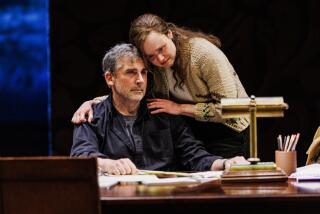Hagen’s Brave, Braying Martha Brings ‘Virginia Woolf’ Alive
- Share via
Be specific, and be brave.
Amid buzzwords and buzz concepts such as locating a character’s objectives and tapping sense memory, the theories explored in Uta Hagen’s textbook “Respect for Acting”--underlined and yellow-highlighted by so many thousands of drama students since 1973--come down to a couple of simple-sounding nutshells: bravery and specificity.
Crystallizing such vast concepts in the service of a role--well, that’s acting, the hard part of it.
About a George Bernard Shaw heroine, Hagen wrote: “St. Joan was 19 when she died. I was 31 when I played her. Years later, Dame Sybil Thorndike, who created the role, asked me when I was going to play the part again. I told her I thought I was too old. She replied, ‘You can only be too young for Joan!’ ”
Who knew? The same holds true for Martha, the indelible venomous core of playwright Edward Albee’s “Who’s Afraid of Virginia Woolf?” It’s true, at least, when it comes to the wonderfully brave, unerringly specific and altogether inspiring Hagen. The way she evokes a memory of the simplest things--orange slices, for example--proves that all that sense-memory stuff works after all.
At Sunday’s Ahmanson Theatre staged reading, the sellout crowd had the collective privilege of watching Hagen, now 80, in action, revisiting a role she originated in 1962.
Last fall in New York, for a similar one-shot benefit reading of “Virginia Woolf,” Hagen took on Martha for the first time in 35 years. Her co-stars were Jonathan Pryce as George, a hapless professor of history but a master of stealth revenge; Matthew Broderick as Nick, a new faculty member, a “gorgeous lunkhead” and fresh meat for Martha; and Mia Farrow as Nick’s alcoholic wife, Honey.
The Ahmanson cast swapped Peter Gallagher for Broderick. Otherwise, the same. And altogether, wonderful.
Hagen relished Albee’s exchanges, the way only a first-rate performer can relish a first-rate romper room of a part. Throaty, flirtatious, her talons slashing this way and that, Hagen’s Martha played straight into the hellaciously funny invective when called for. “I don’t BRAY!” she brayed, following up with an exquisitely toned-down repetition of the same line.
There’s no question that Albee’s harridan, supremely stage-worthy though she is, tends to bring out the obvious Medusa tactics in some actors. (Elizabeth Taylor in the film version, for example.) Yet Hagen ducked the obvious. Martha’s rage and self-loathing and sheer, boozy, desperate loneliness have rarely seemed like such invigorating fun. Hagen and her cohorts, Pryce in particular, made a well-worn modern classic live, breathe and bite as if brand-new.
The actor playing George tends to have an easier time of it. Albee’s play, an August Strindberg amalgam of various family-oriented 1950s TV sitcoms, is simply built that way. George is the smartest one on stage, and when he justifies his latest emotional devastation by saying, calmly, “I hate hypocrisy,” his victory in these wars is assured. Pryce’s simmering take on this character paid off beautifully. Pryce has a way of conveying eminent authority and utter loser in the same instant--just before slipping the knife in.
As Nick, a pretty boy not much more advanced (despite the degrees) than the titular hunk in Albee’s earlier one-act “The American Dream,” Gallagher revealed the character’s baser instincts by degrees, cannily. Farrow came to life particularly in Honey’s breakdown, delivering a blast of pure anguish. The play itself is an anguished yet weirdly energizing experience.
Proceeds from the Ahmanson reading benefited the Center Theatre Group’s youth programs and the HB Playwrights Foundation and Theatre Endowment. From where I sat, everybody benefited.
More to Read
The biggest entertainment stories
Get our big stories about Hollywood, film, television, music, arts, culture and more right in your inbox as soon as they publish.
You may occasionally receive promotional content from the Los Angeles Times.










